Knowing how to tell if a property has subsidence is vital if you are looking to move house any time soon.
Many buyers will shudder at the mere mention of the word, yet, in many cases, it’s not as big a deal as you may first think.
We once had a survey conducted that stated the property had subsidence and ‘probably needed underpinning’. As you can image, that scared us but it turned out not to be as bad as feared.
In this article, we’ll pull on our own experiences to help you understand what subsidence is, how to identify it, and what to do about it.
Let’s Start With The Definition Of Subsidence
According to the dictionary, the meaning of subsidence is…
the gradual caving in or sinking of an area of land.
Another thing to note is that subsidence often happens over a large area, not just in a small localised spot (Whittaker & Reddish, 1989).
When that movement of land starts to cause cracks and structural issues with a property, that’s when the alarm bells should start ringing.
In fact, it may be difficult to get a mortgage on a property with subsidence, not all insurance providers will cover it, and it may be very costly to fix.
But, that’s only when the movement is significant.
This was an issue we faced when our mortgage valuation concluded an upper floor extension had been built on a single brick wall leading to structural damage. You can see the reason in the image below…

In our situation, we spoke to our mortgage provider who said in no uncertain terms they wouldn’t provide a mortgage on the property.
We asked about them reducing the valuation (and us making up the shortfall) or putting a retainer on the mortgage (holding back some funds until we had completed repairs to the issue) but they wouldn’t offer us an solutions beyond finding another property. So, that’s what we ended up doing.
So, as you can see, subsidence is a major issue that can impact your ability to even buy a property in the first place!
And it’s an issue that affects the largest cities on the planet— from Jakarta, Houston, to Mexico City (Bagheri-Gavkosh et al., 2021)! So, UK property owners are definitely not alone in dealing with this issue.
What’s The Difference Between Subsidence & Settlement?
When a new structure is built, the ground it was built on sometimes moves and compresses as it adjusts to the weight of the new structure.
This kind of movement is called ‘settlement’.
While settlement can cause some of the same symptoms as subsidence, any damage is usually relatively minor and will stop fairly soon after the building was erected.
Subsidence, on the other hand, is caused by loss of support underneath the foundations, which can lead to significant problems.
This loss of support is a result of different factors. Poland & Davis (1969) discussed how it happens from the rapid withdrawal of groundwater. Meanwhile, the British Geological Survey highlights the role of the type and percentage of clay present in the soil.
Don’t worry we’ll discuss this in further detail below.
On the other hand, we found that it is difficult to tell if a crack is caused by settlement or subsidence, unless you are an expert, of course.
One of the houses we bought over the years had an extension. The garden had two levels, the first of which had a retaining wall. The extension was built on this level.
When we viewed the house, we discovered a crack in this retaining wall, as well as under the kitchen window of the extension right above it.
The crack was quite deep, so we suspected that the extension was too heavy for the wall, which caused subsidence. A few years earlier, we would have decided not to go for this house, but by then we had quite a bit of experience, so we got a structural survey done.
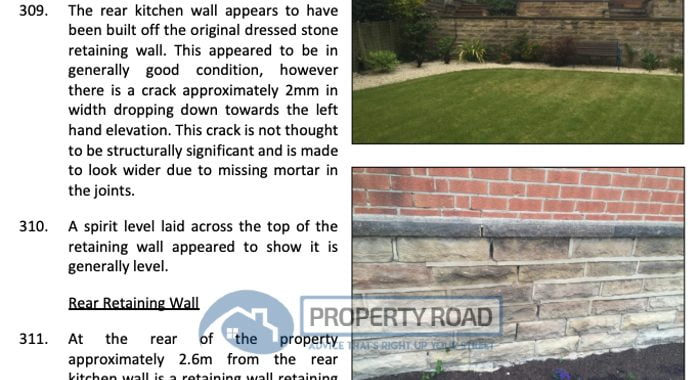
It turned out that the movement was actually settlement, which was long-standing and non-progressive. This meant that any repairs were only cosmetic.
In our experience, it’s worth not getting put off by any bigger crack you see. It might be subsidence, but it might just be settlement.
What’s The Difference Between Heave & Subsidence?
When the ground underneath a building swells up, sometimes because it has taken on too much water, it can cause similar issues to subsidence.
However, this type of movement is called ‘heave’.
Heave is much rarer than subsidence but can still affect properties and cause serious structural issues.
Some buildings can even exhibit displacement in the corners or at the centre of the structure (DeJong & Morgenstern, 1973)
So, the overall impact is similar but heave is when the ground rises under a structure, subsidence is when the ground drops under a structure.
What Are The Signs Of Subsidence?
When looking for signs of subsidence in a property, there are several things you can look out for, including…
Cracked Walls

The best-known and often the most obvious indicators of subsidence are cracked walls.
We’re not talking about a few hairline cracks around window frames or along plasterboard joints – these are almost always just cosmetic.
Instead, we mean significant cracks. If the crack is visible on both sides of the wall or is more than 3mm wide (thicker than a 10p coin), it may indicate a more serious issue.
We used the 10p coin trick many times to check cracks in various properties and we’ve experienced all types of cracks from insignificant hairline ones through to major ones you can put your fingers in!
Keep in mind, if the wall is covered by wallpaper then cracks may not be visible but can be detected by looking for tearing or rippling of wallpaper that isn’t caused by damp.
Here are the most common types of cracks and what they typically mean:
Stepped & Diagonal Cracks
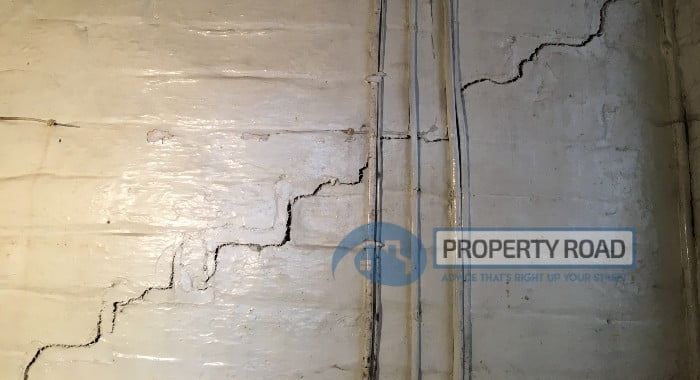
A stepped crack is one which runs up or down a wall but follows the line of the mortar to create a step-like pattern.
Diagonal cracks occur when the crack goes through the bricks rather than following the mortar joints.
Both can indicate that the foundations of the building have moved, though stepped cracks are less likely to be serious.
If the property has a diagonal crack you would be advised to seek the help of a chartered surveyor to assess the seriousness of the problem.
When looking at possible investment properties we have often come across this kind of crack. Usually, it’s a red flag for us and causes us to look elsewhere.
Note in the photo above that as well as the crack, the mortar along the crack line is also much wider than everywhere else? This indicates it’s a serious crack that has been repointed at least once before but has since re-opened.
Vertical Cracks

A crack running down a wall from top to bottom or bottom top in a more or less straight line is classed as a vertical crack.
Again, the crack is likely to indicate more serious issues if it goes through bricks rather than following the mortar joints.
This happened on the vertical crack we had on a retaining wall of our previous home. Thankfully, we had it checked and it was deemed to be non-progressive. We still took action to repair it (we’ll show you how in a moment) but it wasn’t considered a major problem.
Vertical cracks can indicate that one or both ends of the foundations of the building are dropping (subsidence) or that the middle of the wall is rising (heave).
If the wall is a retaining wall a vertical crack may also indicate the wall is failing perhaps due to excessive weight or pressure directly behind, or close to, the crack.
This was the case for the vertical crack we had which was caused by the extension built on top of the retaining wall without any reinforcement of the wall to help it take the weight.
Horizontal Cracks
A crack running from side to side is a horizontal crack and will typically follow the mortar joints rather than breaking through bricks.
That doesn’t make them any less severe, though, as horizontal cracks often are a sign a wall is in the early stages of failure.
Horizontal cracks are most common in retaining walls and often indicate the wall is not strong enough to support the weight of what it is retaining.
We’ve been lucky that we haven’t experienced any significant horizontal cracks in the properties we’ve owned.
Crooked Doorways & Window Frames
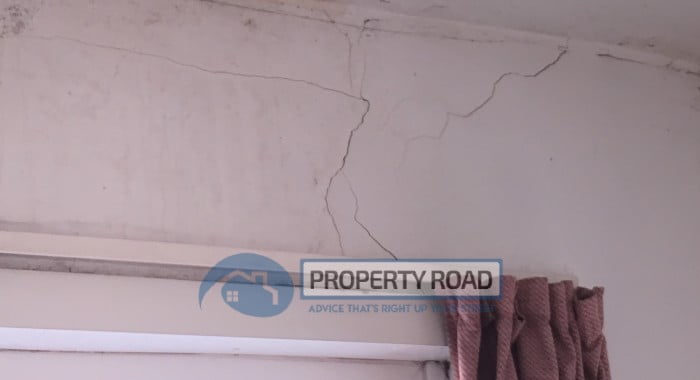
Many people think they know how to tell if a property has subsidence simply because they know to look for cracks.
While cracks are one of the biggest indicators, they are not the only one. Crooked doorways and window frames are another big sign.
That’s because as a property moves, it can sometimes twist or move more in one area than another. This leads to doorways and window frames that don’t quite sit square.
Doors or windows that stick can sometimes be an indication of this (or may just be a sign the hinges need adjusting!) but you can always check whether the frames are level by using a spirit level.
Often this kind of cracks can be hard to spot with the naked eye. On one property we subsequently bought, many of the downstairs door frames were warped or twisted. Even the floor wasn’t properly level!
Yet, during our viewings, we never noticed. In fact, even living there for almost 5 years we hardly could tell. It was only when our surveyor used a spirit level that we could even see what the issue was!
Sloping Or Uneven Floors
The spirit level may come in handy again here as a sloping or uneven floor can also be an indication that the property has moved.
That’s because (in the case of suspended floors) the floor joists are bedded into the walls. Any movement that affects the wall will have a knock-on effect on the floor.
If you own or are considering buying a property that is showing any of these tell-tale signs of subsidence, you should definitely get a survey carried out.
You can use our handy tool to find and compare chartered surveyors near you.
In many cases, you’ll find that any subsidence is considered long-standing and non-progressive and therefore is nothing to worry about.
But, if the issue is more serious, the sooner you deal with it, the better as it will only get worse over time.
What Is Long-Standing, Non-Progressive Subsidence?
We mentioned it in the previous section and if you own or are looking to buy a property with signs of subsidence, “long-standing and non-progressive” is a term you’ll definitely want to hear!
What does it mean? Simply that movement has affected the building but that it happened a long time ago and is no longer considered to be an issue.
In other words, it means that whatever caused the ground to move has stopped having an effect and so no further movement is expected to affect the property.
If your surveyor confirms your subsidence is long-standing and non-progressive it will mean the damage is now only cosmetic and that you’ll find it a little easier to get insurance and a mortgage.
This was something we were relieved to hear from our surveyor when we had to have a structural survey done on a property we wanted to buy. You can see some of his comments in the image below.

If it is unclear whether your subsidence is still progressing, it’s possible to buy a crack monitoring kit to track any changes in the severity of the crack over time.
What Causes Subsidence?
Subsidence can be caused by a number of different issues, sometimes they can be unique to the property in question,
However, the most common causes of subsidence include:
Unstable Ground
Areas that were used for mining in the past are particularly prone to subsidence issues as old mine shafts collapse and the ground moves.
Further analysis of ten UK coalfields by (Yao & Reddish (1994) determined that the duration of residual subsidence directly correlates to the mining depth. If your property is near an active or former mine, it would be best to dig deeper into the specifics.
We used to live in an area of the UK with a strong mining history. This meant that most houses we looked at had some sort of subsidence. However, with the mines long closed, these issues tend to be long-standing and non-progressive.
But it can be quite worrying when you are young and not that experienced. We found that it is important to do some research into the area you want to buy in.
We didn’t at first, so it was quite a shock to see that every house we looked at had cracks or other signs of subsidence. After an estate agent explained that this is fairly normal for this region, due to its mining past, we looked into it.
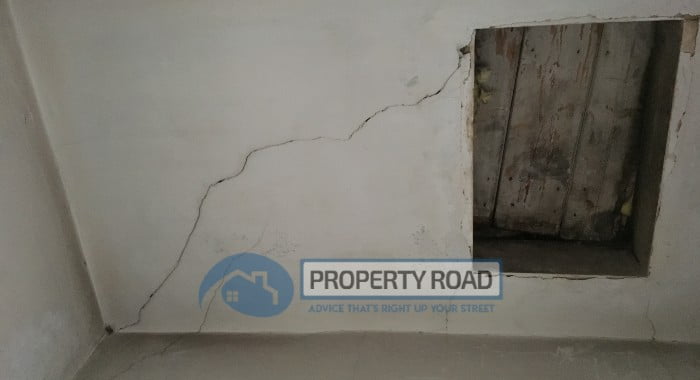
And it was a good thing too, because it meant we were prepared to see cracks without starting to panic.
Certain soil types (such as clay) are also more prone to causing movement, that’s because they tend to expand and shrink depending on the conditions.
Even firmer soils such as those with high amounts of chalk and limestone can cause subsidence as the rocky materials dissolve over time.
So we can definitely recommend gaining an understanding of the make-up of the area you are looking to buy in.
Inadequate Foundations
Sometimes the cause of subsidence is entirely man-made, such as in the case of inadequate foundations.
Often this is an error at the build stage when the builders either didn’t quite get their calculations right or used inferior materials.
However, it can also be introduced at a later stage such as if an extra storey has been added to a property without any strengthening of the foundations to compensate for the extra weight.
This is what happened to us when an extension had been built directly on top of a retaining wall that wasn’t designed to take the weight of a building, causing cracks.
Buying A Property? FREE Step-By-Step Platform
Trees & Bushes
Perhaps surprisingly, trees and bushes are one of the most common causes of subsidence in the UK.
It’s also the reason why you are often asked by insurers whether there are any “trees taller than 10m and within 5m of your property?”
The problem is that the roots of trees and bushes can suck away the moisture in the soil from around the foundations of a building.
This causes the soil to shrink and can lead to movement. In fact, with some trees, the roots themselves can actually grow into the foundations and crack and dislodge the foundations.
We’ve always been very careful to buy properties without trees too close to the building due to this.
Leaking Pipes
Water is also a common cause of subsidence. If you have broken or leaking pipes, either below the ground or draining into the ground, it can wash away soil.
Over time, this can wash out the soil from underneath the foundations of the wall and cause movement.
Unfortunately, pipes leaking underground are hard to spot until the ground has already started moving, by then it may already have caused significant damage.
We were lucky to spot an issue with a leaking pipe on one of the properties we owned before it caused serious issues.
We noticed that where our patio met the house, the slabs had started dropping.
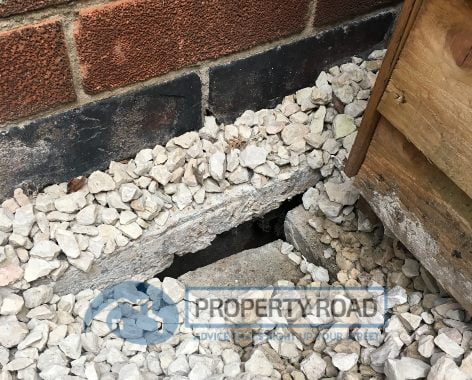
The first step we took was to dig out the area to try and see what was causing the problem.
While we had assumed it may be a collapsed drain, it quickly became evident that the leak was coming from a nearby downpipe that wasn’t connected to pipe in the ground correctly.
Basically, water was flowing out of the pipe and washing away the surrounding soil. Over a period of time, this caused the patio to start falling into what was essentially a sinkhole!
Had we have left it any longer, the chances are the hole would have gotten so big it would have started damaging the foundations of the property. This would then lead to subsidence.
Luckily, because we caught it early, all we had to do was ensure the downpipe was connected to the ground pipe securely with a new adaptor, then fill in the hole.
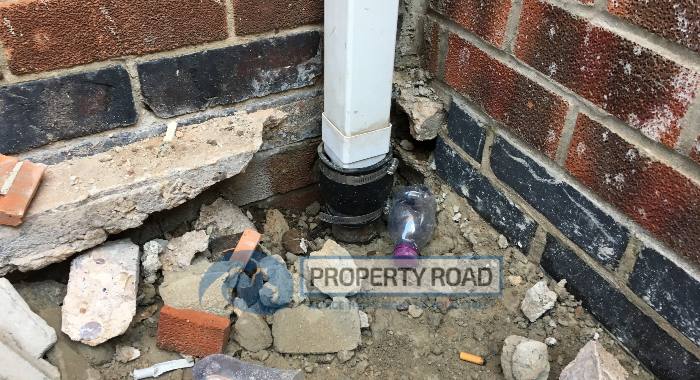
After applying this fix, we didn’t have any further issues and had avoided a more costly subsidence issue.
How To Fix Subsidence
If you’re unlucky enough that your chartered surveyor has confirmed you have or will potentially have structural issues due to subsidence, you’ll need to take remedial action.
Your surveyor should provide advice on the best course of action to take. In most cases it will involve one or more of the following:
Remove The Cause
If your subsidence is caused by trees, bushes, or drainage issues, the very first thing you should do is address the cause.
If this is a drainage issue then you’ll need to stop the leak by fixing the pipes or whatever is causing the issue.
When the problem is caused by trees or bushes, the issue is slightly more complex as simply removing the tree or bush may cause further issues.
Instead, carefully managed pruning may be the best route forward. It’s best to consult with a surveyor and tree surgeon for advice.
Only once the cause is completely addressed and is no longer causing an issue can you look to repair the damage and prevent future problems.
Underpinning
One of the most extreme measures to fix subsidence, underpinning is also one of the most effective.
It involves digging out a cavity below the affected foundations and filling it with concrete. Essentially you are strengthening the foundations of the property.
While it can be a tricky and costly job (particularly if access is difficult), as few as 10% of properties with subsidence actually require underpinning.
It’s therefore only a last resort, especially as it will affect your ability to get home insurance that covers subsidence in the future.
Wall Ties
In some cases, subsidence issues can be resolved using wall ties.
These vary from large metal plates attached to one side of a wall and tightened, through to metal rods that are placed inside the mortar joints.
Typically, they’ll be used when a wall is leaning or on retaining walls that are struggling to cope with the weight behind them.
Often they’ll be used in addition to strengthening the foundations.
This is the repair we chose to do to our retaining wall that had experienced a vertical crack. While our structural survey had indicated the crack was not significant and did not need any repair, we wanted to do something to strengthen the wall to be safe.
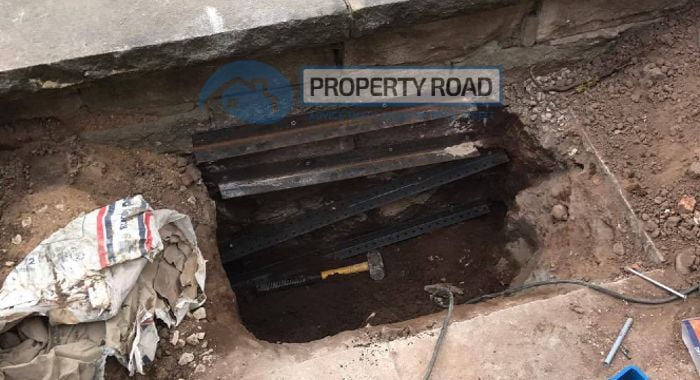
Our method (or rather, our builder’s method!) was to dig down behind the crack and to bold several wall ties where the crack was. We then had the hold we dug backfilled with a strong concrete mix.
This meant we had provided a lot of extra support to the wall exactly where it needed it, plus, it was all covered up again so it was completely invisible to anyone who didn’t know it was there. Winner!
Wall Buttresses
A wall buttress is sometimes used in severe cases of movement where a wall needs significant additional support to avoid collapsing.
The buttress is simply another brick wall that’s built at an angle to lean into the wall that is suffering from movement.
It counteracts the pressure to provide increased stability. Buttresses are often seen on older buildings that have suffered from obvious subsidence.
Address The Cosmetics
Once the main causes of subsidence have been addressed and the necessary fixes applied you’ll probably need to address the cosmetic damage.
This should only be done once you are sure there will be no further subsidence issues to avoid the cosmetic damage re-appearing.
Smaller cracks should be able to be addressed with crack filling compound, sanding, and repainting.
More significant cracking may require a whole reskim of the plaster of the wall.
- The original versatile filler
- Ready mixed for a smooth, creamy consistency
- Special binders give guarenteed adhesion
Can You Get A Mortgage On A Property With Subsidence?
We have focused a lot on how to tell if a property has subsidence and what to do about it, but what effect does subsidence have on your ability to get a mortgage?
Put simply, significant subsidence will put many mortgage lenders off.
Of those that will still lend to you, many will request that you get a proper survey carried out by a qualified professional to assess the risk level.
Again, the magic words you are looking for are ‘long-standing and non-progressive’. If your surveyor states this term then most mortgage lenders will be happy to proceed.
Keep in mind though that it may still affect your ability to get insurance and most mortgage lenders require adequate buildings insurance to be in place as a condition of your mortgage.
It’s best to speak to a good mortgage advisor to find out exactly where you stand once you understand more about the level of subsidence your property has.
As you saw with our experience earlier, sometimes a mortgage provider will just refuse flat out to give you a mortgage on a property with subsidence. In this case, you’ll either need to find a mortgage provider who will still give you a mortgage, or you’ll need to find a new property.
A good mortgage advisor will be able to help you to find a lender that is willing to lend you money for the property with subsidence.
So, Should You Buy A House With Subsidence?
This is the big question. If you have found your dream home, but it appears to be suffering from subsidence, should you still buy it?
There’s no right or wrong answer to that. It depends on your attitude towards risk and whether you are prepared to spend the money to put things right.
Virtually any problem can be rectified if you throw enough money at it. The question is more, can you afford the time, money and stress to fix things?
For us, most cracks and subsidence issues have been relatively easy and cost-effective to fix. However, we have viewed properties where the subsidence would be just too much of a risk and so we’ve had to walk away.
Whatever you decide, your first step should always be to seek the advice of an expert, in this case, a chartered surveyor, so you understand the full picture.
Once you know exactly what kind of problems you face, and how difficult it will be to resolve them, you can make the decision whether to proceed with buying the property.
So, hopefully, our experiences have helped educate you on how to tell if a property has subsidence.








